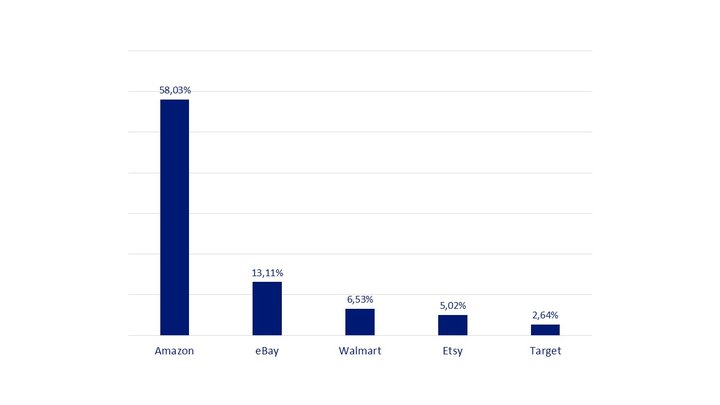Amazon leads the ranking of online sales in E-commerce in the US

As has happened in most countries, e-commerce has grown as never before in the United States of America in the wake of the pandemic. With 332 million inhabitants, the United States is the third most populous country in the world only surpassed by India and China; and almost 80% of American Internet users purchase products and services online.
According to Statista, the revenue generated by this type of transaction reached 670 billion US dollars in 2023 and is estimated to reach 1.1 trillion US dollars in 2028.
In this article, we learn a little more about the profile of the American consumer and who are the undisputed kings of e-commerce in the United States.
As by the previously cited study from Statista, in April 2023, Amazon was the leading marketplace in the United States by a wide margin of 40%. The online retail giant accounted for almost 60% of the desktop traffic recorded in the marketplace category. The top 5 is followed by:
- Ebay, the famous online sales and auction website.
- Walmart, the world's largest chain in the retail channel.
- Etsy, the e-commerce website where members can sell handmade products or vintage items.
- Target, the well known american department store chain.
United States online consumer profile
As in most countries, consumer behaviour in the United States has radically changed in the last two decades, and it has done so faster in the last few years.
Ownership of smartphones
In May 2023, 90% of Americans already owned a smartphone, according to Pew Research.
That’s a huge increase from the 35% who owned a device back in 2011. Having a smartphone, of course, makes it easier to shop online anytime and everywhere.
Another noteworthy fact is that social networks are used by an increasing percentage (72%), which explains the significant role they play both in digital advertising and in their development as true marketplaces.
Not only are smartphones the devices most used by the population, but in 2023. The average value of mobile purchases has increased by more than 28 US dollars, reaching more than 125 US dollars for the first time.
This data has had a positive impact on the retail market. In fact, 42% of the total reported e-commerce revenue in the country came from mobile sales.

Most demanded categories
If we talk about the most popular categories, fashion and accessories are at the top (16,9%), followed by furniture and household appliances (13,7%).
Although categories such as books, music, computers and consumer electronics do not appear in this ranking, online sales for these types of products are significant (69.1% and 53.2% of sales, respectively), according to the ICEX report on e-commerce in the United States.
Payment habits
Regarding the means of payment chosen by Americans, credit cards, debit cards and digital wallets are the most used, accounting for 90% of online transactions.
In addition, another fact that can be extracted from the Icex report cited above is that the United States ranks second in the world in terms of average per capita spending on the Internet, with 3,033 euros, behind the United Kingdom.
Challenges for shipping companies
The rapid growth of e-commerce has also created new challenges for freight forwarding, logistics and distribution companies when providing quality international shipping services for e-commerces:
- Increased demand: Americans have increased their spending on online shopping, straining the capacity of logistics companies who must meet this growing demand for last-mile delivery.
- Free shipping: Another challenge they face is providing free shipping as an included service for their companies. United States consumers are paying much more attention to the shipping costs and more and more of them expect the delivery costs to be covered by the online shops from which they make their purchases.
- Increased shipping complexity: transporting online orders is becoming even more complex and challenging, and sustainability parameters must be considered in the face of an increasingly environmentally conscious consumer.
Technological advances such as artificial intelligence will undoubtedly help to address these challenges and will influence the future of e-commerce, not only in the United States, but also in the rest of the world.
Challenges in United States E-Commerce
The United States e-commerce market has seen tremendous growth. However, this expansion has created challenges for logistics companies, which are faced with increasing demand and shipping complexity. What is predictable and that we are already seeing, is that the adoption of innovative technologies will be key to overcoming these obstacles and supporting the continued expansion of e-commerce in the United States.

